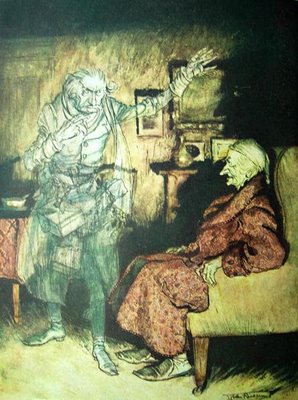The Morgan Library and Museum in Manhattan owns the entire handwritten manuscript of A Christmas Carol by Charles Dickens. The 66-page manuscript written in 1843 bears all of Dickens’ edits in his own hand. “He worked on it with loving care, doing much more rewriting than usual.” (1) The original story is written in light blue ink. Edits are in thick, black ink.
One edit is visible on page 12, where Scrooge encounters Marley’s ghost, and chalks up the vision to indigestion. Dickens originally wrote “a spot of mustard” then changed it to read: a “blot of mustard.”
The manuscript is exhibited each holiday season but, alas, only one page is put on view each year, under glass. This year, however, the Morgan has allowed the New York Times to photograph and display the entire handwritten treasure online at
http://www.nytimes.com/interactive/2009/11/30/nyregion/dickens-christmas-carol-pages.html
The Morgan challenges readers to go online and study the manuscript and submit what they think is the most interesting edit in the work. The contestant judged to have submitted the most intriguing edit will be invited as the newspaper’s guest to afternoon tea at the Morgan.
What motivated Charles Dickens to write his classic holiday ghost story?
“At the time A Christmas Carol was written, Dickens feared for his future. He had six children to feed, a large house in London to maintain, and a lavish lifestyle. Christmas was approaching.
Yet Martin Chuzzlewit, the work he was then producing, a few chapters at a time, was not selling as well as earlier installments of The Pickwick Papers or Nicholas Nickleby. Bitterly, he confided to a friend that his bank account was bare….
Conjuring up what Dickens himself described as a “ghost of an idea,”…he got to work. The 6,000 copies printed in time for Christmas sold out. But because he had splurged on hand-colored drawings by John Leech, one of England’s leading illustrators, the project was a financial bust.
Fortunately for Dickens, his quickie book went on to become a classic.” (2)
(1) Stanley, Diane and Vennema, Peter. Charles Dickens: The Man Who Had Great Expectations. New York: Morrow Junior Books, 1993.
(2) “Dickens the Editor To Dickens the Writer: Make it Sell.” The New York Times. A29. December 2, 2009.
Readers: Check out these other related posts:
“Grip the Raven” about Dickens’ pet raven
“Nellie Bly: Charles Dickens’ Visit to Blackwell Island Asylum 1842”





















